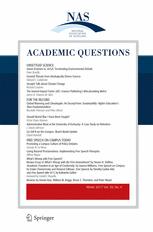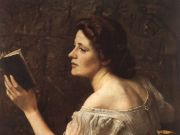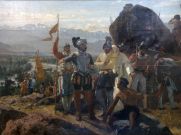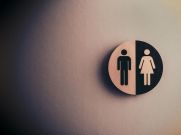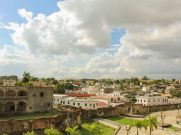Patrick J. Deneen is David A. Potenziani Memorial Associate Professor of Constitutional Studies at the University of Notre Dame, Notre Dame, IN 46556; [email protected]. He is the author of The Odyssey of Political Theory (Rowman & Littlefield, 2000) and Democratic Faith (Princeton University Press, 2005).
This piece originally appeared in “God and Guns,” a special section of the Winter 2014 Academic Questions (volume 27, number 4).
I came of intellectual age during the first wave of the academic culture wars, in the midst of battles that were heating up throughout the 1980s and which hit fever pitch with the publication of Allan Bloom’s best-selling jeremiad, The Closing of the American Mind, published in 1987.[1] Bloom was either widely praised or excoriated as a conservative defender of the liberal arts, which he viewed as the source of the ideas that animated and sustained Western civilization. I have now reached some intellectual seniority as the second wave of the academic “culture wars” washes over us, one that pits liberals who defend an ever-more extensive program of “political correctness” against conservatives who argue that higher education as currently constituted is a poor investment in an age of straitened economic opportunity and soaring college costs, and call instead for education aligned much more closely to career demands and especially preparation in science, technology, engineering, and mathematics (STEM).
In effect, almost no interest in defending the liberal arts as a central value remains among the combatants in today’s culture wars. In the 1980s, for all the evident vitriol, there was a shared agreement that it was worth arguing over the kinds of books and authors who should be widely assigned in college curricula; at the very least, there was agreement that the heart of the educational endeavor should be the liberal arts, and that it mattered deeply what works were generally assigned in shaping the intellectual lives and moral imaginations of students. Today, there is almost a studied neglect of such a concern. Both sides—liberal and conservative, for the most part—view the main end of higher education as a practical project with little connection to the liberal arts. Instead, each side stresses the value of an education that can be fulfilled by something other than the liberal arts. For the Left, its main aim is educating global citizens who empathize with the disadvantaged, who support various forms of identity politics including LBGTQ rights and gay marriage, who are versed in “sustainability,” and who are sensitive to various forms of “diversity” and readily “check their privilege.” Meanwhile, a growing chorus of voices on the right point to the unsustainable economic model of higher education, dismissing the liberal project of fostering political correctness as a luxury item that most students cannot afford and don’t need, and demanding an increasingly monetized set of measurements and standards for evaluating the worth of higher education, in particular a strict accounting for “return on investment.”
Both positions represent a betrayal of the proper mission of higher education, which is the formation of young people for lives of responsible liberty grounded in a deep encounter with those lessons as they have been developed in the cultural inheritance of the West. The reason these two positions have become regnant is directly related to an approximately century-long process of disaffiliation of the nation’s colleges and universities from their various religious foundations, identities, and commitments.
In this essay, I advance two connected arguments: (1) the conservative aims of the “first” culture wars—particularly the restoration of the “great books” of the Western canon—does not represent a wished-for alternative, but the dying gasp and brief interregnum following the demise of colleges and universities as religious institutions; and (2) that moment was short-lived because it represented a transition between two competing ideals of liberty—one informed by classical and particularly Christian inheritance, the other by modern philosophic trends that favor applied science and technology—and, despite its apparent devotion to the classics, was itself deeply shaped by the latter conception of liberty that ushered in its own demise.
A Brief Interregnum
Anthony T. Kronman offers a compelling and largely accurate historical canvas in his 2008 Education’s End: Why Our Colleges and Universities Are Giving Up on the Meaning of Life.[2] He delineates three main historical phases of postsecondary education in America. First, what he calls the “age of piety” reigned from the colonial era in the mid-seventeenth century until the mid-nineteenth century. This was the era during which colleges that were founded by and affiliated with religious denominations viewed education as an extension of religious belief and education. Next came what Kronman calls the “age of secular humanism,” which arose in the late-nineteenth century and lasted until the 1960s. This was the era of “pluralism,” in which meaning and truth were debated and debatable, and during which many programs in the great books arose. We are now in the unfolding of the third stage, “the research ideal,” a period when the humanities are increasingly displaced by the pursuit of “new knowledge” achieved most extensively through the natural and applied sciences.
While Kronman notes that the longest of these three phases was the first—the age of piety—he clearly prefers the second phase, the age of secular humanism. This was the time when there was no orthodoxy, but instead an intense openness and interest in questions about “the meaning of life.” Kronman mourns the eclipse of that age—one that was relatively brief, about a century, in comparison to the first phase—and laments the ascent of the research ideal, in which the natural and applied sciences enjoy place of primacy and the humanities have largely descended into dogmas of political correctness.
Kronman’s lament for the passing of the age of secular humanism maps perfectly onto Allan Bloom’s analysis twenty years earlier, in which Bloom made a similar defense of the Western tradition and criticized the counterculture of the 1960s and the rise of multicultural education. But while Bloom intimated that the study of the great books devoted to exploring the meaning of life constituted a long tradition that could trace its roots back to the philosophic activity of Socrates in antiquity, Kronman accurately notes that the period of the “great books” that Bloom valorizes was an interregnum between two distinctive and fundamentally hostile worldviews. While it was one that Bloom ahistorically regards as the longstanding tradition of the West, Kronman provides a historically fuller account of why the interregnum was, in fact, “unstable.”[3]
The age of secular humanism arose in opposition to the religious establishment and identity of the religiously-affiliated institutions. It rejected the dogmas of the various religious traditions in accordance with which university education once took place and presumed instead a pluralist approach to questions about truth and meaning. The aim of a university education that is valorized by Kronman becomes the pursuit of the meaning of life, understood to be an aim that each person must answer individually, and, presumptively, a pursuit in which there can be no right answer to the question—hence, pluralism. Each person must instead answer fundamental questions individually and by his own lights. Within this activity lay a deeper assumption about human nature, one according to which, in Kronman’s words, there is “room to fulfill our [elementary needs] in a variety of ways, and even permits these needs themselves to assume different forms. The openness and plasticity of human nature are as impressive as its limits. Indeed, each of us can make, and wants to make, a life uniquely our own.”[4]
In spite of a radical break from the religious assumptions of colleges and universities as originally founded, in which education aimed at a deeper knowledge and understanding of the truths already held by faith and discerned through reason, by certain appearances the educational approach of the period praised by Kronman and Bloom alike appeared to be fundamentally unchanged. An education in secular humanism and pluralism was organized along lines that had existed for two hundred years in America, and for centuries and even millennia in Europe: that questions of meaning and truth can only be understood through the encounter with great texts from the past, a grappling with timeless questions, the answers to which every generation must discover anew. So, even as the age of secular humanism embraced individually-defined truth and human “plasticity,” it organized this endeavor around the great books and set up a variety of programs that emulated the now-superseded religiously-based form of education. With the widespread dismantling of religious affiliations and identities, extensive effort was dedicated to replacing religious “canons” with a newly constituted canon of the great books. Even as course requirements changed, higher education remained centrally focused on identifying and promoting knowledge of the great books. During this time, a plethora of programs and curricula arose that for several decades constituted the various “core curricula” that Bloom and Kronman variously defend and whose passing they lament.
Yet, what Kronman describes as a middle period between the age of piety and the research ideal was one of “instability.” The reason for this instability was not simply, as Kronman suggests, that it attempted to occupy a position somewhere between certainty (the age of piety) and skepticism (the research ideal), but that it proved to be a transitional period between competing ideas and ideals of liberty.
Two Concepts of Liberty, One Place for Liberal Arts
It is deeply revealing that the content of the liberal arts has ceased to be the central focus of debate, as it was during the first wave of the academic culture wars. The liberal arts, as the name attests, is fundamentally concerned with educating for liberty, and the extent to which the liberal arts are no longer considered of central concern by the dominant voices of higher education, it is reasonable to conclude that a fundamental shift in the understanding of liberty has occurred. However, that shift does not constitute a simple rejection of liberty—liberty has never ceased to be an aim and goal of higher education and of American civilization—but rather a fundamental change in how liberty is conceived and cultivated.
Two concepts of liberty have animated two respective eras of higher education. The first concept of liberty—classical and especially Christian—was dominant during the first period of American higher education (Kronman’s age of piety) and its main means of cultivation was through the liberal arts—especially classical languages, ancient texts, particularly Greek and Roman—and religious works. The second concept of liberty—modern and “liberal”—has dominated during the ascent of the research ideal, with particular emphasis upon STEM. The classical and Christian conception understood liberty to be a form of self-control and self-governance, and thus stressed the inculcation of virtue and the formation of character through self-discipline and self-command over the appetites. The modern and liberal understanding of liberty is largely conceived as the absence of external restraints upon the achievement of wants and desires, and thus seeks to overcome obstacles to the achievement of individual ends and goals.
The classical and Christian understanding of liberty required ongoing recourse to the main texts of the premodern Western intellectual tradition, and especially classics of ancient Greece and Rome along with the Bible and Christian texts. Because each generation had to learn anew the lessons that were hard-won since antiquity—the demands of self-command along with the attendant temptations to self-aggrandizement—each generation was expected to return to the classics not (according to Kronman’s telling) to determine, individually, the meaning of life, but to encounter the lessons to be learned in the hubris of Oedipus, the anger of Achilles, and the allure and dangers of the contemplative and active lives; the lessons in ethics and politics disclosed by Plato, Aristotle, Cicero and others; and the admonition to live in self-sacrificial imitation of Christ while inevitably failing due to the inheritance of original sin. An education in the liberal arts was thus aimed at a comprehensive, shared education in virtue and formation of character directed at forming the free—liberal—person. The goal of education was liberty as a form of self-command, while its opposite—enslavement—was most fully realized not even when one was the subject of another’s will, but when one was incapable of exercising control over one’s own will. For the ancients and Christians alike, a person was unfree when unable to exert self-command over appetites, whether individually (as learned in ethics) or collectively (as learned through the study of politics).
By contrast, the modern understanding of liberty stressed individual autonomy, self-direction, and the widest exercise of individual choice. Inaugurated in the writings of such thinkers as Francis Bacon, Thomas Hobbes, and John Locke, modern liberty was achieved not primarily through self-command and self-limitation, but rather the expansion of free action. For this reason, the main thinkers of this modern tradition regarded the ancient authors as deeply and often perversely mistaken, and they often explicitly rejected and even attacked the Aristotelian and Scholastic tradition—along with their influence upon and presence in the liberal arts—in favor of an education in the natural and applied sciences. The classical and Christian emphasis upon the liberal arts therefore limited the modern understanding of freedom, and its condemnation of indulgence in appetite as a form of enslavement represented a direct contradiction to modern liberal commitments, especially as these expanded in modern times. Modern liberty therefore required an education that largely eschewed the liberal arts, or, if they persisted, were rendered compatible with the individualist assumptions of modern liberty.[5]
For this reason, the middle period of secular humanism described by Kronman and the ideal of the great books defended by Bloom constituted a transitional move away from the classical and Christian emphasis upon the liberal arts based upon a premodern understanding of liberty in favor of the modern ideal of liberty as autonomy and self-direction. Even while Kronman and Bloom praised an education in the great books—extolled by Kronman as resources for individuals to discover and define for themselves the meaning of life—they implicitly favored such study for their support of the exercise of modern liberty, and especially, the expansion of individual choice. The more great books and the more options of different philosophies the better. They contained a marketplace of ideas that could support a plethora of lifestyle choices.
This transitional period predictably gave way after an interregnum to the aims of the research ideal, and especially the emphasis upon STEM. It was especially through applied science—technology and engineering—that modern liberty was most supported and advanced. By extending human mastery and control over nature, by increasing human power and dominion, by making the world subject to thoroughgoing human planning and control, humans expanded their freedom by increasing their ability to achieve all of their wants—and even create ones heretofore unknown. The declining interest in and debate about the liberal arts is not an accidental feature of modern higher education but an inevitable consequence of the rejection of the basic understanding of liberty during the age of piety. With the loss of religious affiliation and mission, America’s institutions of higher education have been on a steady and wholly predictable trajectory of rejecting the central relevance of the liberal arts in favor of those areas of study and research that expand human power. After all, following Francis Bacon, the modern project equates knowledge not as self-knowledge and self-command, but rather with power.
Persistence of the Older View
Today’s contestation about the nature of higher education represents the two sides of the same coin of modern liberty. The Left advances the hope that students will be formed to respect diversity, cosmopolitanism, social justice, and every possible form of equality by race, gender, and sexual identity. The Right increasingly stresses the need for colleges to focus on financial, economic, and scientific criteria and advances. Both increasingly neglect the place and role of the liberal arts in higher education, because both reject the classical and Christian understanding of liberty that the liberal arts sought to foster and inculcate. The two positions are more fundamentally alike than different, sharing the view that liberty is best understood in the modern sense, with particular stress upon individual agency, autonomy, and the expansion of human control and mastery. Both are increasingly negligent of and even hostile toward the idea that the past and tradition is a repository of accumulated wisdom, and that education is a conveyance of a cultural inheritance. In light of this shared view, the liberal arts continue to wane.
While a number of voices on the right continue to look back to the period in the mid-twentieth century when it seemed that programs devoted to study of the great books could take the place of the religious missions and affiliations of colleges and universities, we must now recognize this as a transition from the classical and Christian conception of liberty to the modern form of liberty that stresses, above all, autonomy and the need for endlessly-increasing human power. We are now decisively and with ever-greater conformity entering a new phase of higher education where Left and Right agree that the main end of higher education should be devoted to the modern notion of liberty. They differ only in means, and in fact both approaches coexist with relative peace and even compatibility on most campuses today.[6]
Understanding the nature of the transformation on our campuses, and that contemporary “debates” are actually focused on means and not ends, clarifies what is at stake as we contemplate the future of higher education and the fate of the West. At the very least, we can perceive more clearly where the actual debate lies and can evaluate with clarity the respective goals that have variously animated higher education from the beginning of the American project. For those who believe that the rejection of the classical and Christian understanding of liberty is the source of a plethora of contemporary woes—from the treatment of the world and the human body as mere material for hedonism, to the incoherence of the simultaneous emphasis in the academy on social justice and utilitarian materialism—it is a perilous time. But civilizations have declined before, and from the ashes have arisen chastened and often better ways. In the meantime, all this makes ever more crucial the task of the institutions that still maintain an understanding of the older ideal of liberty—religiously-affiliated colleges and universities, and organizations and institutions dedicated to classical learning. They must endeavor ever more mightily to keep alive the ideals of the liberal arts and to continue educating the rising generations in the art of being free.
Image: Public Domain
[1]Allan Bloom, The Closing of the American Mind: How Higher Education Has Failed Democracy and Impoverished the Souls of Today’s Students (New York: Simon & Schuster, 1987).
[2]Anthony Kronman, Education’s End: Why Our Colleges and Universities Are Giving Up on the Meaning of Life (New Haven, CT: Yale University Press, 2008).
[3]Ibid., 172.
[4]Ibid., 78.
[5]See my essay, “Against Great Books: Questioning Our Approach to the Western Canon,” First Things, January 2013, http://www.firstthings.com/article/2013/01/against-great-books.
[6]See my essay, “Loss of Vocation and the Demise of the University,” Ethika Politika, May 21, 2014, http://ethikapolitika.org/2014/05/21/loss-vocation-demise-university/.




